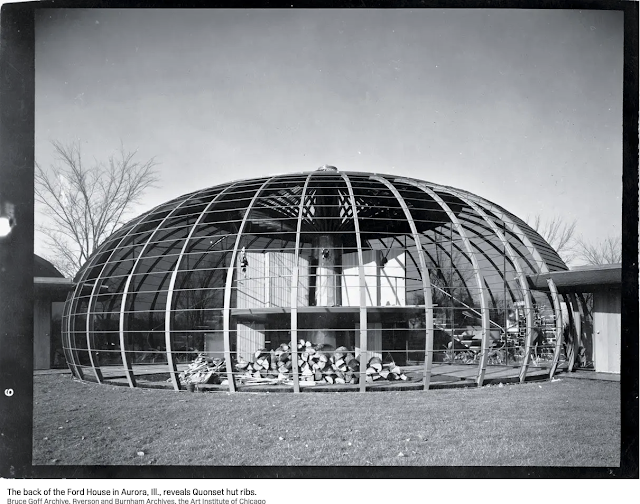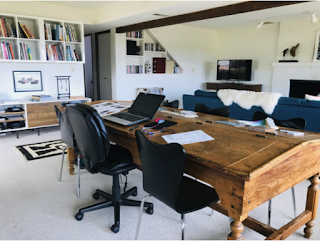 |
| 'House for Betta,' 1988, by architect James Schildroth |
Organic architecture is not about assembling boxes and coating them with candy floss. For that, read your latest glossy "architecture" magazine or Instagram page -- or watch the latest episode of Grand Designs. Former Frank Lloyd Wright apprentice James Walter Schildroth explains that to design organic architecture, you need to start not from without but from within. Why? Because, as he says, "This is architecture not sculpture art. What is important is the human being who will use the space." Organic architecture puts human beings in relation to the world beyond. "Space never confines. Space is always in relation to the beyond."
Here's how he learned to design for human beings this way apprenticing at Frank Lloyd Wright's practice...
Learning to design at Taliesin
By James Walter Schildroth, Architect
When I arrived at Taliesin in September of 1959, I had good drafting skills and had taken three years of mechanical drawing in high school and one year in junior college. I had been reading several of Mr. Wright’s book including A Testament and the The Natural House. I had been mentored by Will Willsey, Architect and Taliesin apprentice in 1954-55. Will, had introduced me to the use of the ‘unit system’ and I was working out designs using the four-foot square unit. I did not understand how to get an original design. I was just emulating the Wrightian design and making a few of my own changes.
I wanted to learn how to create original form and ideas. This why I had come to Taliesin and I was determined to learn and would stay as-long-as it took to know if I could do it or not.
The idea for an original design was the goal. How did Mr. Wright and others do it?
Organic is “of the thing and not something applied for the outside.” It is not copied or made to look like something that exists. I could make a logical floor plan but the plan was not the idea, it was just a floor plan. The idea must come from some other place, but where and how?
Breaking the box was much talked about.
Someone explained that if one was making a floor plan of a 120 square-metre house, they could draw a rectangle 10m x 12m and fit all the rooms inside. This was not the ‘Organic Way.’ The Organic way, was to let the individual areas of the house be put in a relationship to the site as well as in a relationship to each other.
Ask each function or area what it needed. Start with the parts and put each part on the site plan where it was best served.
An example is a breakfast area. Now most people eat breakfast in the early morning and may want the morning sun coming in the window. So that would locate the breakfast area on the east side of the plan. Continue this with all the areas of the house plan.
I call the function areas of the house the ‘Parts.’
Mr. Wright’s saying: “Part is to part as part is to, whole.”
This exercise is not a design it is the beginning of understanding the needs in relationship the conditional requirements of the project.
I learned to do this on the topographical site plan and place the parts of the areas on the site plan at the same scale. I made cutouts of each area like bedrooms, labeled each one and so could move these areas around on the site and in relationship to each other. The result was an organisational relationship. This is not a floor plan yet. What it does is point out the problems that need to be resolved. You learn very quickly that if the lot is small and the area needs are large that you will have a two-floor house.
Put each area in the best location and you will have some conflicts.
Mr. Wright’s saying: “The solution to the problem is contained within the conditions of the problem.”
Understanding the problem is the most important beginning. I learned not to start by sketching or making drawings.
So, what can I do? How can I make a design without drawing it?
Mr. Wright said that he did the design in his mind before any drawing. I said to myself “if Mr. Wright said it was the way he did it, I would try it.” After completely understanding the site and the requirements I did not focus on what the design could be. I did not look for an existing design to copy. I did not start sketching. I did something else, anything else.
As I was doing other things often a partial idea or even a way to solve one of the problems would come into my mind. These beginning ideas are not fully formed and need to be kept in the mind to develop. If you sketch them, you will freeze them and it will be more difficult to allow them to develop and change.
Mr. Wright said: “Let the idea stay in your mind until it more fully develops so you can visualize it and walk through it inside and outside.” When you can see the idea in your mind, then is the time to start to draw it.
I also start to think about a design by putting myself on the real site and seeing the features of the site all around me. I let the design develop around me. I do not look at the design from the outside but from the interior space in relationship to the site features.
Organic Space
I learned that Mr. Wright was not simply making floor plans, he was drawing plans that represented the space he had in his mind.
What is ‘Organic Space’?
It is not a room. It is not a box with holes for windows.
“Organic space shelters and defines but never limits or confines” is my way of putting the concept. The areas are in a relationship with the whole of the interior and the site features on the outside.
Jack Howe taught us not to trap space but to find a way to let it flow beyond.
Space is far more than area or volume.
Space engages and involves the mind of the person that is having the experience. This involvement invites the mind of the person experiencing the architecture to be in relationship to the architecture by completing the space in the imagination.
Space never confines. Space is always in relation to the beyond.
Space allows the mind to complete, in imagination that which goes beyond.
Organic Space shelters and defines but never limits or confines.
Some of the so-called organic shapes to my mind do not have this aspect of Space. They have curvilinear shapes that are called organic, but they are still boxes, because they confine and contain the same as a rectangular box. To be Organic, Architecture must have this quality of Organic Space. It must allow the mind of the person to freely play with the infinite just as it does in the out of doors in nature.
Buildings are made with a floor, walls, and a roof. How the architect does this makes all the difference. The usual way is a box room put together with a lot of other boxes. This is trapped space a kind of prison. To break the box, one must let the edges go beyond the walls and the roof. Just as the floor inside goes outside through a sliding glass door to the wood deck. The walls can also go from inside to beyond outside giving the feeling of openness and continuity. The walls become protective screens and masses of stone or brick with open glass areas between. The whole of the interior is in relationship with features of the site outside. The ways to do this are infinite and up to the designer’s talent. I always let the function guide my choices.
Mr. Wright’s saying: “Form and function are one.” This is architecture not sculpture art. What is important is the human being who will use the space."
 |
| 'House for Betta,' 1988, by architect James Schildroth |





























































